Strategic Planning Report: Vodafone Growth and Expansion Strategies
VerifiedAdded on 2023/01/19
|9
|2211
|88
Report
AI Summary
This report provides a detailed analysis of Vodafone's strategic planning and growth strategies. It begins with a strategic audit, encompassing stakeholder and environmental analyses, as well as organizational audits and strategic positioning techniques. The report then evaluates Vodafone's expansion strategy, including PESTLE and SWOT analyses, competitor analysis, and market entry strategies. It explores strategic options like mergers and diversification, evaluating their suitability, feasibility, and acceptability. Finally, the report outlines an action plan for implementing these strategies, including resource allocation and timelines, concluding with a summary of key findings and recommendations for Vodafone's future growth and success. The report is based on the coursework reassessment for a module on strategic management.
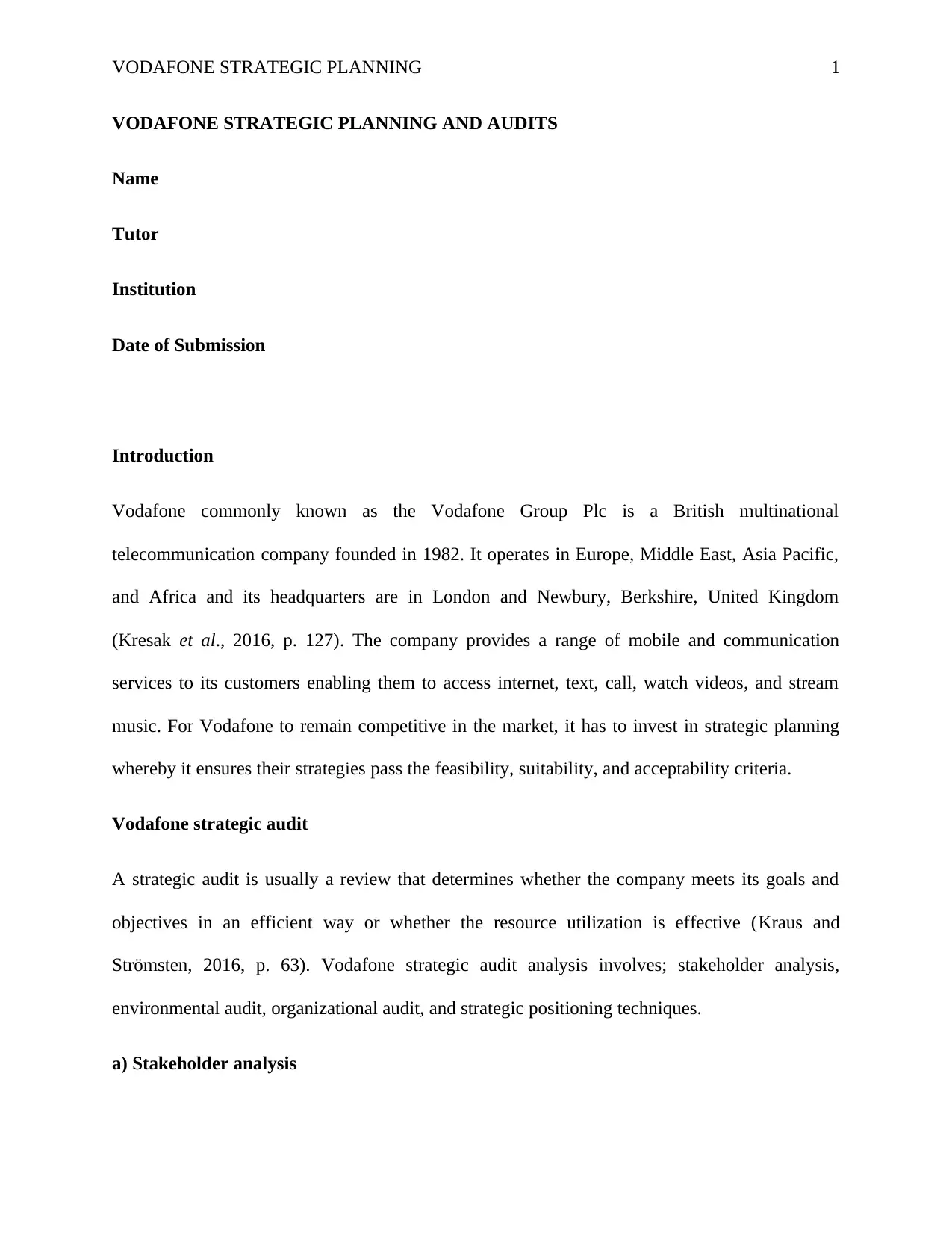
VODAFONE STRATEGIC PLANNING 1
VODAFONE STRATEGIC PLANNING AND AUDITS
Name
Tutor
Institution
Date of Submission
Introduction
Vodafone commonly known as the Vodafone Group Plc is a British multinational
telecommunication company founded in 1982. It operates in Europe, Middle East, Asia Pacific,
and Africa and its headquarters are in London and Newbury, Berkshire, United Kingdom
(Kresak et al., 2016, p. 127). The company provides a range of mobile and communication
services to its customers enabling them to access internet, text, call, watch videos, and stream
music. For Vodafone to remain competitive in the market, it has to invest in strategic planning
whereby it ensures their strategies pass the feasibility, suitability, and acceptability criteria.
Vodafone strategic audit
A strategic audit is usually a review that determines whether the company meets its goals and
objectives in an efficient way or whether the resource utilization is effective (Kraus and
Strömsten, 2016, p. 63). Vodafone strategic audit analysis involves; stakeholder analysis,
environmental audit, organizational audit, and strategic positioning techniques.
a) Stakeholder analysis
VODAFONE STRATEGIC PLANNING AND AUDITS
Name
Tutor
Institution
Date of Submission
Introduction
Vodafone commonly known as the Vodafone Group Plc is a British multinational
telecommunication company founded in 1982. It operates in Europe, Middle East, Asia Pacific,
and Africa and its headquarters are in London and Newbury, Berkshire, United Kingdom
(Kresak et al., 2016, p. 127). The company provides a range of mobile and communication
services to its customers enabling them to access internet, text, call, watch videos, and stream
music. For Vodafone to remain competitive in the market, it has to invest in strategic planning
whereby it ensures their strategies pass the feasibility, suitability, and acceptability criteria.
Vodafone strategic audit
A strategic audit is usually a review that determines whether the company meets its goals and
objectives in an efficient way or whether the resource utilization is effective (Kraus and
Strömsten, 2016, p. 63). Vodafone strategic audit analysis involves; stakeholder analysis,
environmental audit, organizational audit, and strategic positioning techniques.
a) Stakeholder analysis
Paraphrase This Document
Need a fresh take? Get an instant paraphrase of this document with our AI Paraphraser
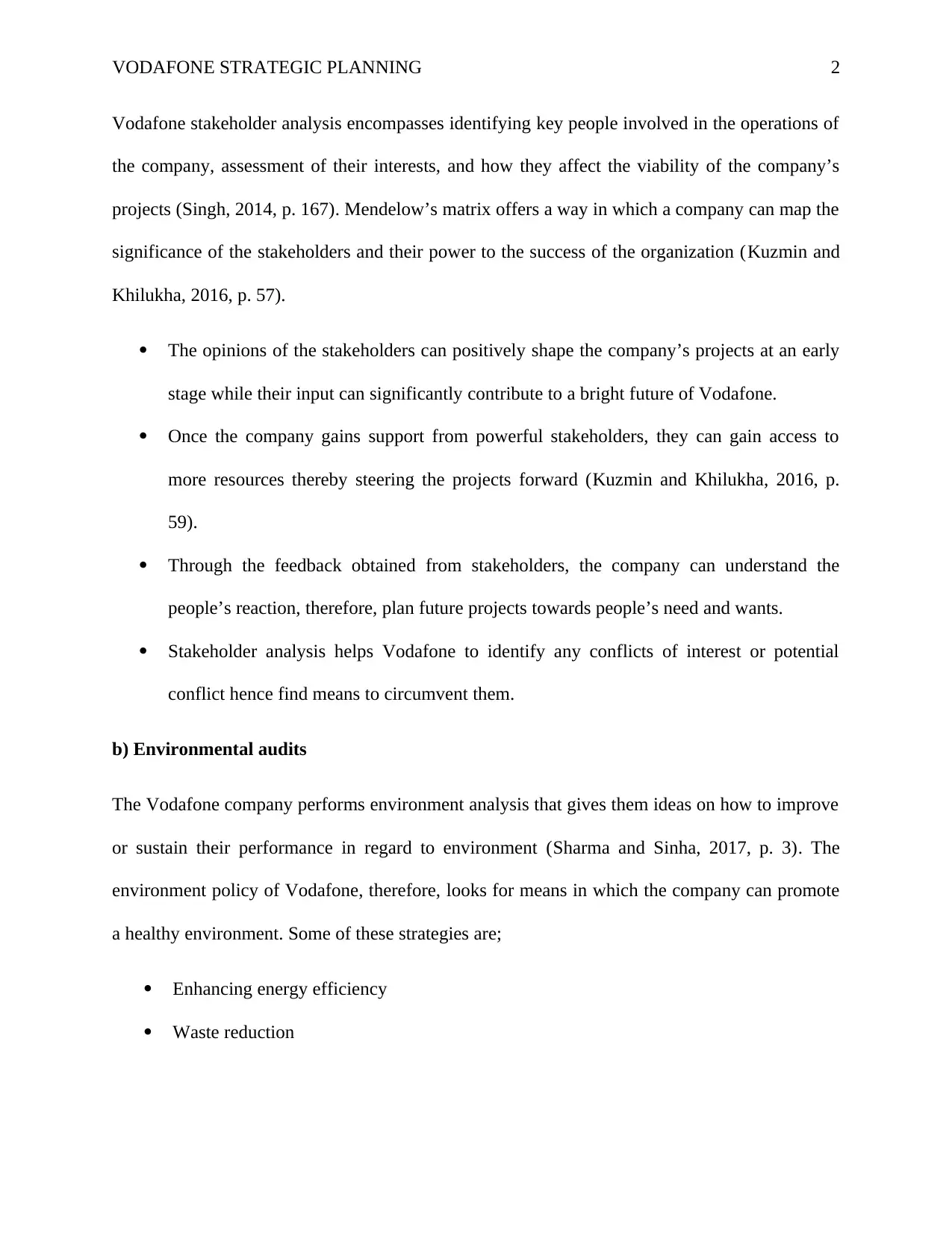
VODAFONE STRATEGIC PLANNING 2
Vodafone stakeholder analysis encompasses identifying key people involved in the operations of
the company, assessment of their interests, and how they affect the viability of the company’s
projects (Singh, 2014, p. 167). Mendelow’s matrix offers a way in which a company can map the
significance of the stakeholders and their power to the success of the organization (Kuzmin and
Khilukha, 2016, p. 57).
The opinions of the stakeholders can positively shape the company’s projects at an early
stage while their input can significantly contribute to a bright future of Vodafone.
Once the company gains support from powerful stakeholders, they can gain access to
more resources thereby steering the projects forward (Kuzmin and Khilukha, 2016, p.
59).
Through the feedback obtained from stakeholders, the company can understand the
people’s reaction, therefore, plan future projects towards people’s need and wants.
Stakeholder analysis helps Vodafone to identify any conflicts of interest or potential
conflict hence find means to circumvent them.
b) Environmental audits
The Vodafone company performs environment analysis that gives them ideas on how to improve
or sustain their performance in regard to environment (Sharma and Sinha, 2017, p. 3). The
environment policy of Vodafone, therefore, looks for means in which the company can promote
a healthy environment. Some of these strategies are;
Enhancing energy efficiency
Waste reduction
Vodafone stakeholder analysis encompasses identifying key people involved in the operations of
the company, assessment of their interests, and how they affect the viability of the company’s
projects (Singh, 2014, p. 167). Mendelow’s matrix offers a way in which a company can map the
significance of the stakeholders and their power to the success of the organization (Kuzmin and
Khilukha, 2016, p. 57).
The opinions of the stakeholders can positively shape the company’s projects at an early
stage while their input can significantly contribute to a bright future of Vodafone.
Once the company gains support from powerful stakeholders, they can gain access to
more resources thereby steering the projects forward (Kuzmin and Khilukha, 2016, p.
59).
Through the feedback obtained from stakeholders, the company can understand the
people’s reaction, therefore, plan future projects towards people’s need and wants.
Stakeholder analysis helps Vodafone to identify any conflicts of interest or potential
conflict hence find means to circumvent them.
b) Environmental audits
The Vodafone company performs environment analysis that gives them ideas on how to improve
or sustain their performance in regard to environment (Sharma and Sinha, 2017, p. 3). The
environment policy of Vodafone, therefore, looks for means in which the company can promote
a healthy environment. Some of these strategies are;
Enhancing energy efficiency
Waste reduction
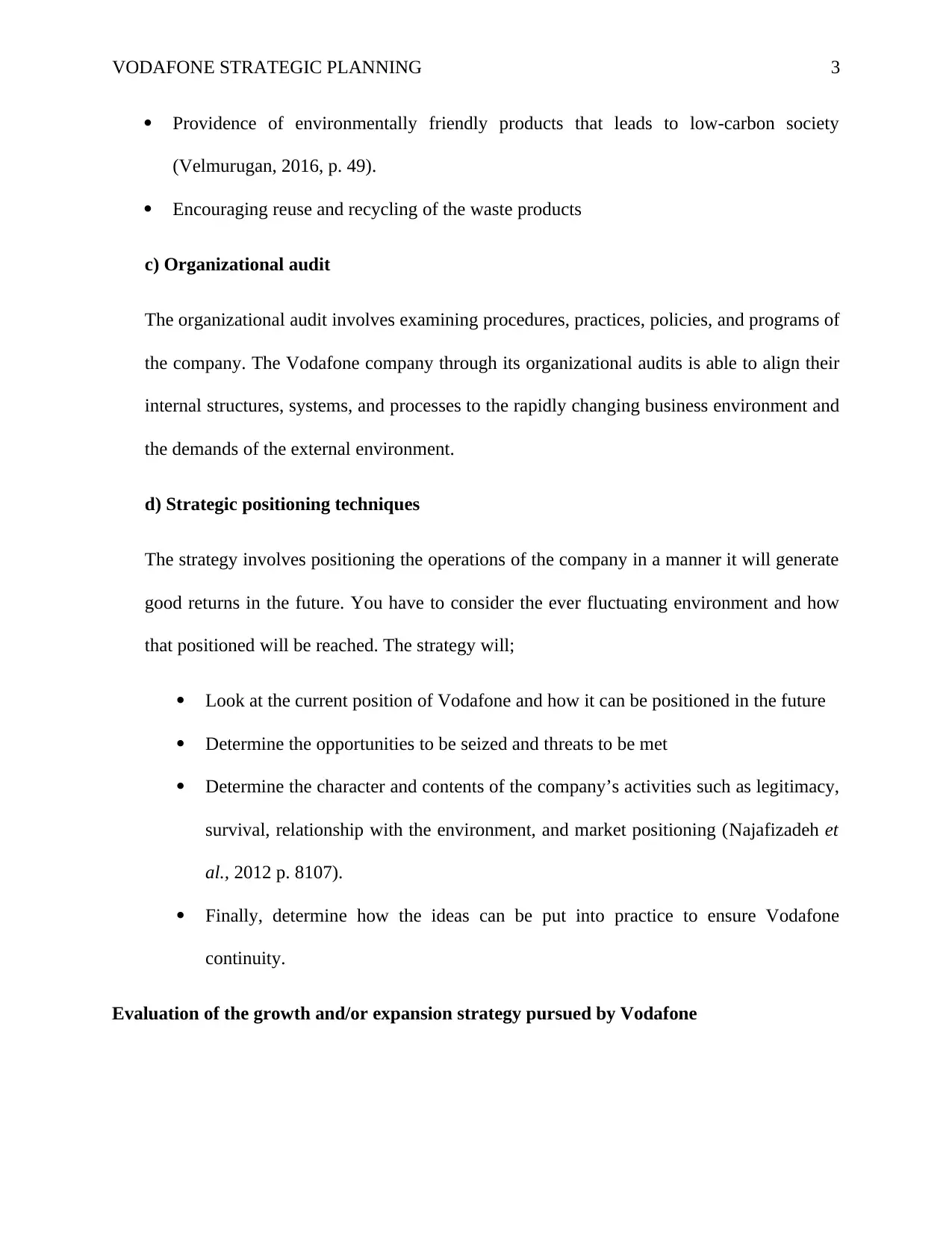
VODAFONE STRATEGIC PLANNING 3
Providence of environmentally friendly products that leads to low-carbon society
(Velmurugan, 2016, p. 49).
Encouraging reuse and recycling of the waste products
c) Organizational audit
The organizational audit involves examining procedures, practices, policies, and programs of
the company. The Vodafone company through its organizational audits is able to align their
internal structures, systems, and processes to the rapidly changing business environment and
the demands of the external environment.
d) Strategic positioning techniques
The strategy involves positioning the operations of the company in a manner it will generate
good returns in the future. You have to consider the ever fluctuating environment and how
that positioned will be reached. The strategy will;
Look at the current position of Vodafone and how it can be positioned in the future
Determine the opportunities to be seized and threats to be met
Determine the character and contents of the company’s activities such as legitimacy,
survival, relationship with the environment, and market positioning (Najafizadeh et
al., 2012 p. 8107).
Finally, determine how the ideas can be put into practice to ensure Vodafone
continuity.
Evaluation of the growth and/or expansion strategy pursued by Vodafone
Providence of environmentally friendly products that leads to low-carbon society
(Velmurugan, 2016, p. 49).
Encouraging reuse and recycling of the waste products
c) Organizational audit
The organizational audit involves examining procedures, practices, policies, and programs of
the company. The Vodafone company through its organizational audits is able to align their
internal structures, systems, and processes to the rapidly changing business environment and
the demands of the external environment.
d) Strategic positioning techniques
The strategy involves positioning the operations of the company in a manner it will generate
good returns in the future. You have to consider the ever fluctuating environment and how
that positioned will be reached. The strategy will;
Look at the current position of Vodafone and how it can be positioned in the future
Determine the opportunities to be seized and threats to be met
Determine the character and contents of the company’s activities such as legitimacy,
survival, relationship with the environment, and market positioning (Najafizadeh et
al., 2012 p. 8107).
Finally, determine how the ideas can be put into practice to ensure Vodafone
continuity.
Evaluation of the growth and/or expansion strategy pursued by Vodafone
⊘ This is a preview!⊘
Do you want full access?
Subscribe today to unlock all pages.

Trusted by 1+ million students worldwide
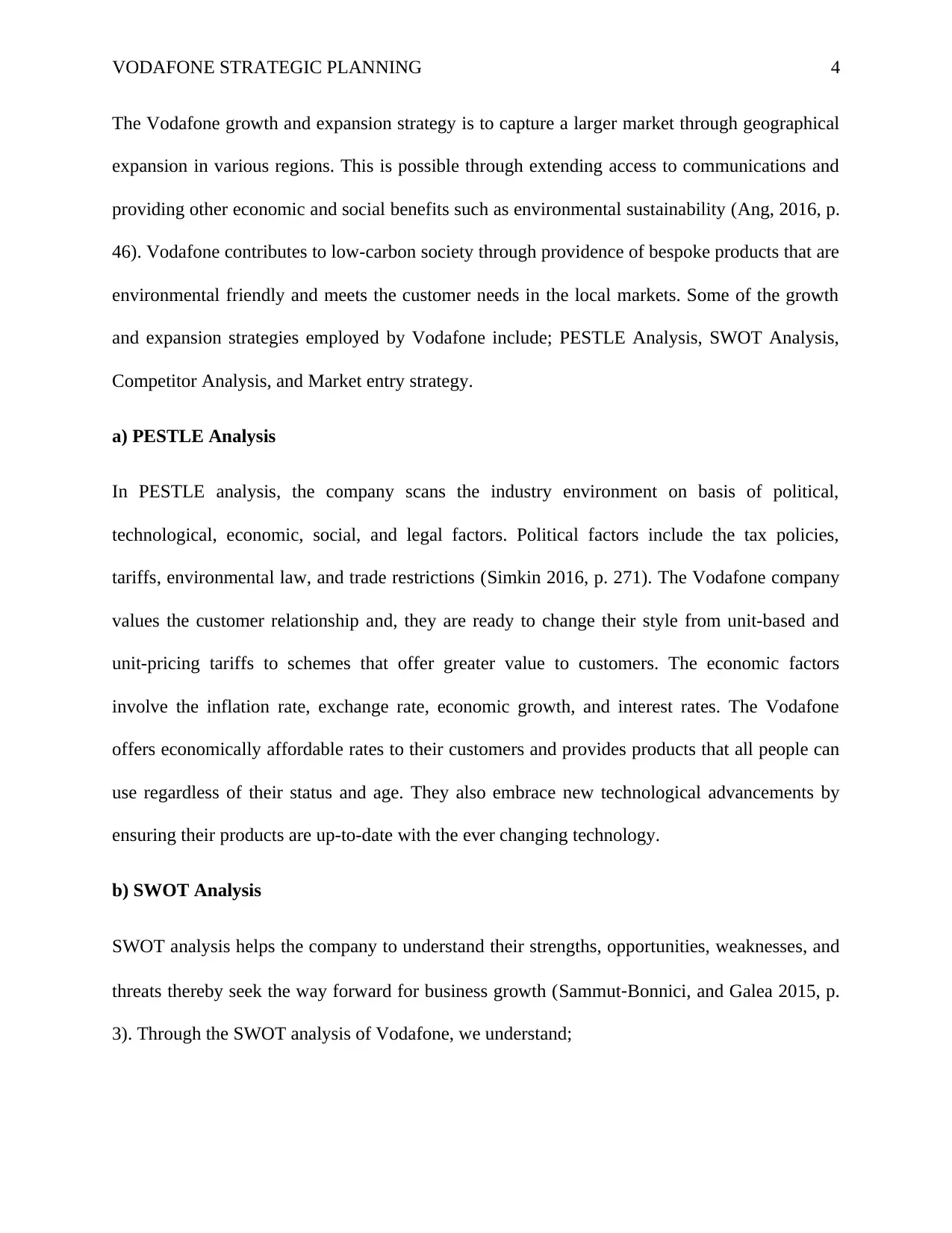
VODAFONE STRATEGIC PLANNING 4
The Vodafone growth and expansion strategy is to capture a larger market through geographical
expansion in various regions. This is possible through extending access to communications and
providing other economic and social benefits such as environmental sustainability (Ang, 2016, p.
46). Vodafone contributes to low-carbon society through providence of bespoke products that are
environmental friendly and meets the customer needs in the local markets. Some of the growth
and expansion strategies employed by Vodafone include; PESTLE Analysis, SWOT Analysis,
Competitor Analysis, and Market entry strategy.
a) PESTLE Analysis
In PESTLE analysis, the company scans the industry environment on basis of political,
technological, economic, social, and legal factors. Political factors include the tax policies,
tariffs, environmental law, and trade restrictions (Simkin 2016, p. 271). The Vodafone company
values the customer relationship and, they are ready to change their style from unit-based and
unit-pricing tariffs to schemes that offer greater value to customers. The economic factors
involve the inflation rate, exchange rate, economic growth, and interest rates. The Vodafone
offers economically affordable rates to their customers and provides products that all people can
use regardless of their status and age. They also embrace new technological advancements by
ensuring their products are up-to-date with the ever changing technology.
b) SWOT Analysis
SWOT analysis helps the company to understand their strengths, opportunities, weaknesses, and
threats thereby seek the way forward for business growth (Sammut‐Bonnici, and Galea 2015, p.
3). Through the SWOT analysis of Vodafone, we understand;
The Vodafone growth and expansion strategy is to capture a larger market through geographical
expansion in various regions. This is possible through extending access to communications and
providing other economic and social benefits such as environmental sustainability (Ang, 2016, p.
46). Vodafone contributes to low-carbon society through providence of bespoke products that are
environmental friendly and meets the customer needs in the local markets. Some of the growth
and expansion strategies employed by Vodafone include; PESTLE Analysis, SWOT Analysis,
Competitor Analysis, and Market entry strategy.
a) PESTLE Analysis
In PESTLE analysis, the company scans the industry environment on basis of political,
technological, economic, social, and legal factors. Political factors include the tax policies,
tariffs, environmental law, and trade restrictions (Simkin 2016, p. 271). The Vodafone company
values the customer relationship and, they are ready to change their style from unit-based and
unit-pricing tariffs to schemes that offer greater value to customers. The economic factors
involve the inflation rate, exchange rate, economic growth, and interest rates. The Vodafone
offers economically affordable rates to their customers and provides products that all people can
use regardless of their status and age. They also embrace new technological advancements by
ensuring their products are up-to-date with the ever changing technology.
b) SWOT Analysis
SWOT analysis helps the company to understand their strengths, opportunities, weaknesses, and
threats thereby seek the way forward for business growth (Sammut‐Bonnici, and Galea 2015, p.
3). Through the SWOT analysis of Vodafone, we understand;
Paraphrase This Document
Need a fresh take? Get an instant paraphrase of this document with our AI Paraphraser
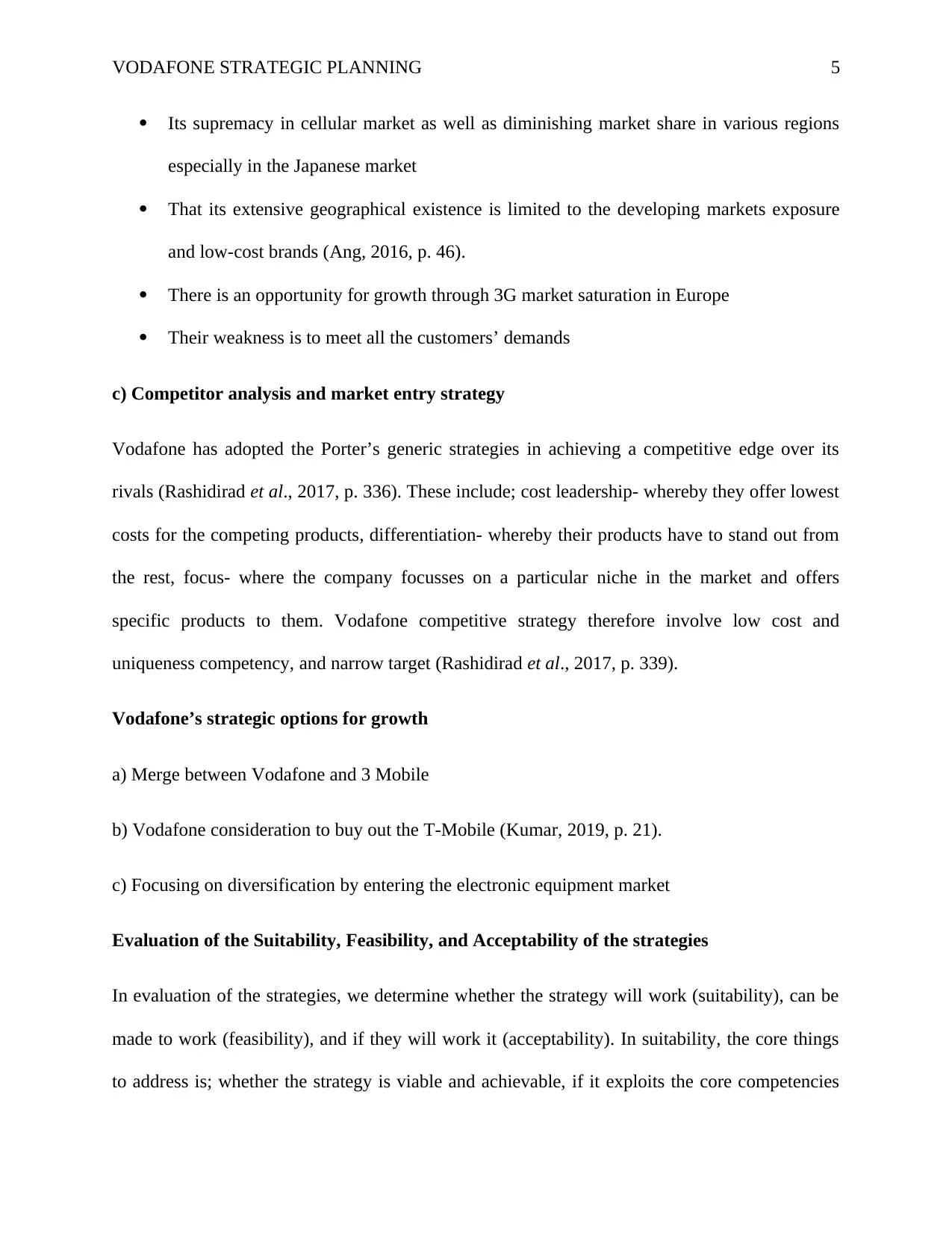
VODAFONE STRATEGIC PLANNING 5
Its supremacy in cellular market as well as diminishing market share in various regions
especially in the Japanese market
That its extensive geographical existence is limited to the developing markets exposure
and low-cost brands (Ang, 2016, p. 46).
There is an opportunity for growth through 3G market saturation in Europe
Their weakness is to meet all the customers’ demands
c) Competitor analysis and market entry strategy
Vodafone has adopted the Porter’s generic strategies in achieving a competitive edge over its
rivals (Rashidirad et al., 2017, p. 336). These include; cost leadership- whereby they offer lowest
costs for the competing products, differentiation- whereby their products have to stand out from
the rest, focus- where the company focusses on a particular niche in the market and offers
specific products to them. Vodafone competitive strategy therefore involve low cost and
uniqueness competency, and narrow target (Rashidirad et al., 2017, p. 339).
Vodafone’s strategic options for growth
a) Merge between Vodafone and 3 Mobile
b) Vodafone consideration to buy out the T-Mobile (Kumar, 2019, p. 21).
c) Focusing on diversification by entering the electronic equipment market
Evaluation of the Suitability, Feasibility, and Acceptability of the strategies
In evaluation of the strategies, we determine whether the strategy will work (suitability), can be
made to work (feasibility), and if they will work it (acceptability). In suitability, the core things
to address is; whether the strategy is viable and achievable, if it exploits the core competencies
Its supremacy in cellular market as well as diminishing market share in various regions
especially in the Japanese market
That its extensive geographical existence is limited to the developing markets exposure
and low-cost brands (Ang, 2016, p. 46).
There is an opportunity for growth through 3G market saturation in Europe
Their weakness is to meet all the customers’ demands
c) Competitor analysis and market entry strategy
Vodafone has adopted the Porter’s generic strategies in achieving a competitive edge over its
rivals (Rashidirad et al., 2017, p. 336). These include; cost leadership- whereby they offer lowest
costs for the competing products, differentiation- whereby their products have to stand out from
the rest, focus- where the company focusses on a particular niche in the market and offers
specific products to them. Vodafone competitive strategy therefore involve low cost and
uniqueness competency, and narrow target (Rashidirad et al., 2017, p. 339).
Vodafone’s strategic options for growth
a) Merge between Vodafone and 3 Mobile
b) Vodafone consideration to buy out the T-Mobile (Kumar, 2019, p. 21).
c) Focusing on diversification by entering the electronic equipment market
Evaluation of the Suitability, Feasibility, and Acceptability of the strategies
In evaluation of the strategies, we determine whether the strategy will work (suitability), can be
made to work (feasibility), and if they will work it (acceptability). In suitability, the core things
to address is; whether the strategy is viable and achievable, if it exploits the core competencies
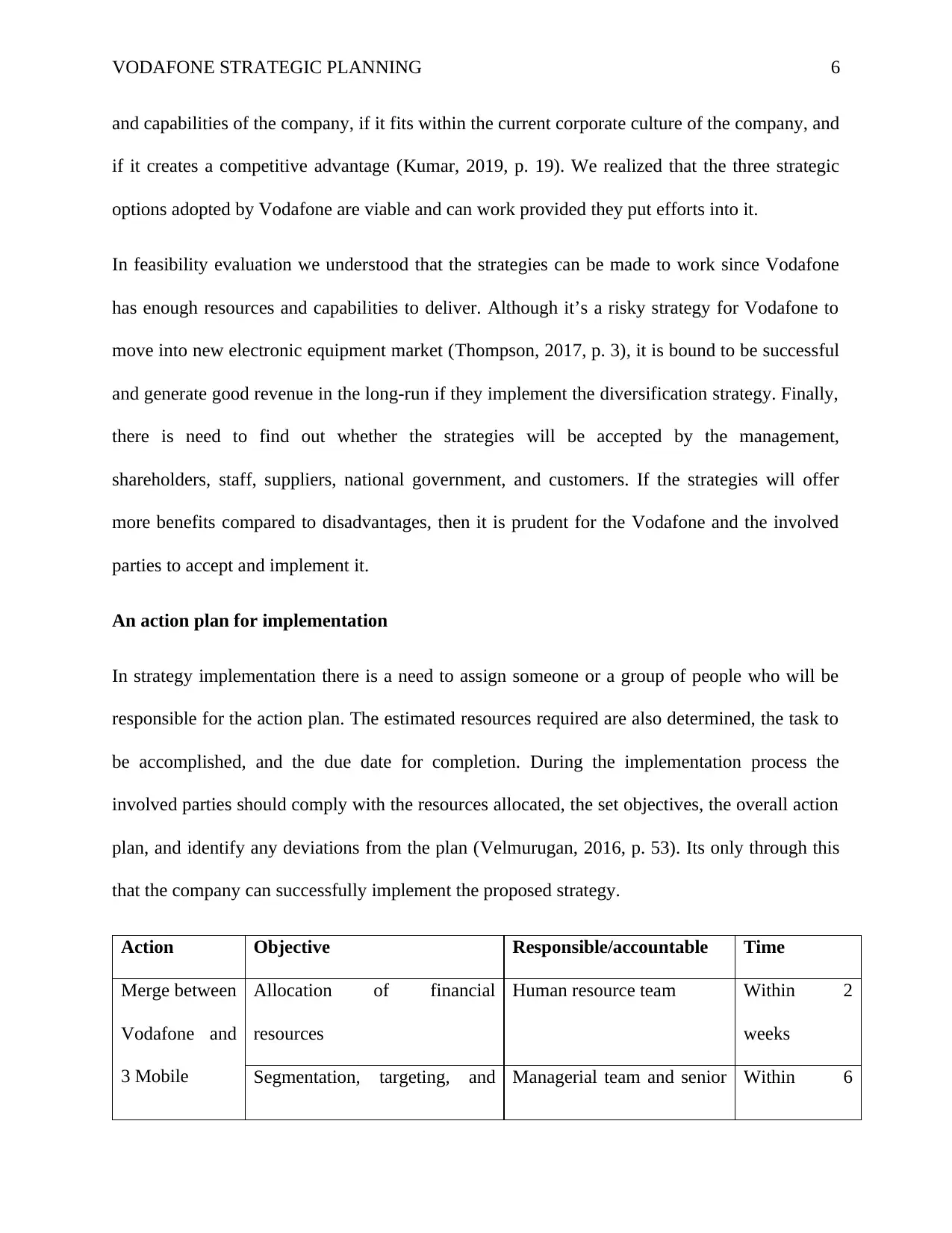
VODAFONE STRATEGIC PLANNING 6
and capabilities of the company, if it fits within the current corporate culture of the company, and
if it creates a competitive advantage (Kumar, 2019, p. 19). We realized that the three strategic
options adopted by Vodafone are viable and can work provided they put efforts into it.
In feasibility evaluation we understood that the strategies can be made to work since Vodafone
has enough resources and capabilities to deliver. Although it’s a risky strategy for Vodafone to
move into new electronic equipment market (Thompson, 2017, p. 3), it is bound to be successful
and generate good revenue in the long-run if they implement the diversification strategy. Finally,
there is need to find out whether the strategies will be accepted by the management,
shareholders, staff, suppliers, national government, and customers. If the strategies will offer
more benefits compared to disadvantages, then it is prudent for the Vodafone and the involved
parties to accept and implement it.
An action plan for implementation
In strategy implementation there is a need to assign someone or a group of people who will be
responsible for the action plan. The estimated resources required are also determined, the task to
be accomplished, and the due date for completion. During the implementation process the
involved parties should comply with the resources allocated, the set objectives, the overall action
plan, and identify any deviations from the plan (Velmurugan, 2016, p. 53). Its only through this
that the company can successfully implement the proposed strategy.
Action Objective Responsible/accountable Time
Merge between
Vodafone and
3 Mobile
Allocation of financial
resources
Human resource team Within 2
weeks
Segmentation, targeting, and Managerial team and senior Within 6
and capabilities of the company, if it fits within the current corporate culture of the company, and
if it creates a competitive advantage (Kumar, 2019, p. 19). We realized that the three strategic
options adopted by Vodafone are viable and can work provided they put efforts into it.
In feasibility evaluation we understood that the strategies can be made to work since Vodafone
has enough resources and capabilities to deliver. Although it’s a risky strategy for Vodafone to
move into new electronic equipment market (Thompson, 2017, p. 3), it is bound to be successful
and generate good revenue in the long-run if they implement the diversification strategy. Finally,
there is need to find out whether the strategies will be accepted by the management,
shareholders, staff, suppliers, national government, and customers. If the strategies will offer
more benefits compared to disadvantages, then it is prudent for the Vodafone and the involved
parties to accept and implement it.
An action plan for implementation
In strategy implementation there is a need to assign someone or a group of people who will be
responsible for the action plan. The estimated resources required are also determined, the task to
be accomplished, and the due date for completion. During the implementation process the
involved parties should comply with the resources allocated, the set objectives, the overall action
plan, and identify any deviations from the plan (Velmurugan, 2016, p. 53). Its only through this
that the company can successfully implement the proposed strategy.
Action Objective Responsible/accountable Time
Merge between
Vodafone and
3 Mobile
Allocation of financial
resources
Human resource team Within 2
weeks
Segmentation, targeting, and Managerial team and senior Within 6
⊘ This is a preview!⊘
Do you want full access?
Subscribe today to unlock all pages.

Trusted by 1+ million students worldwide
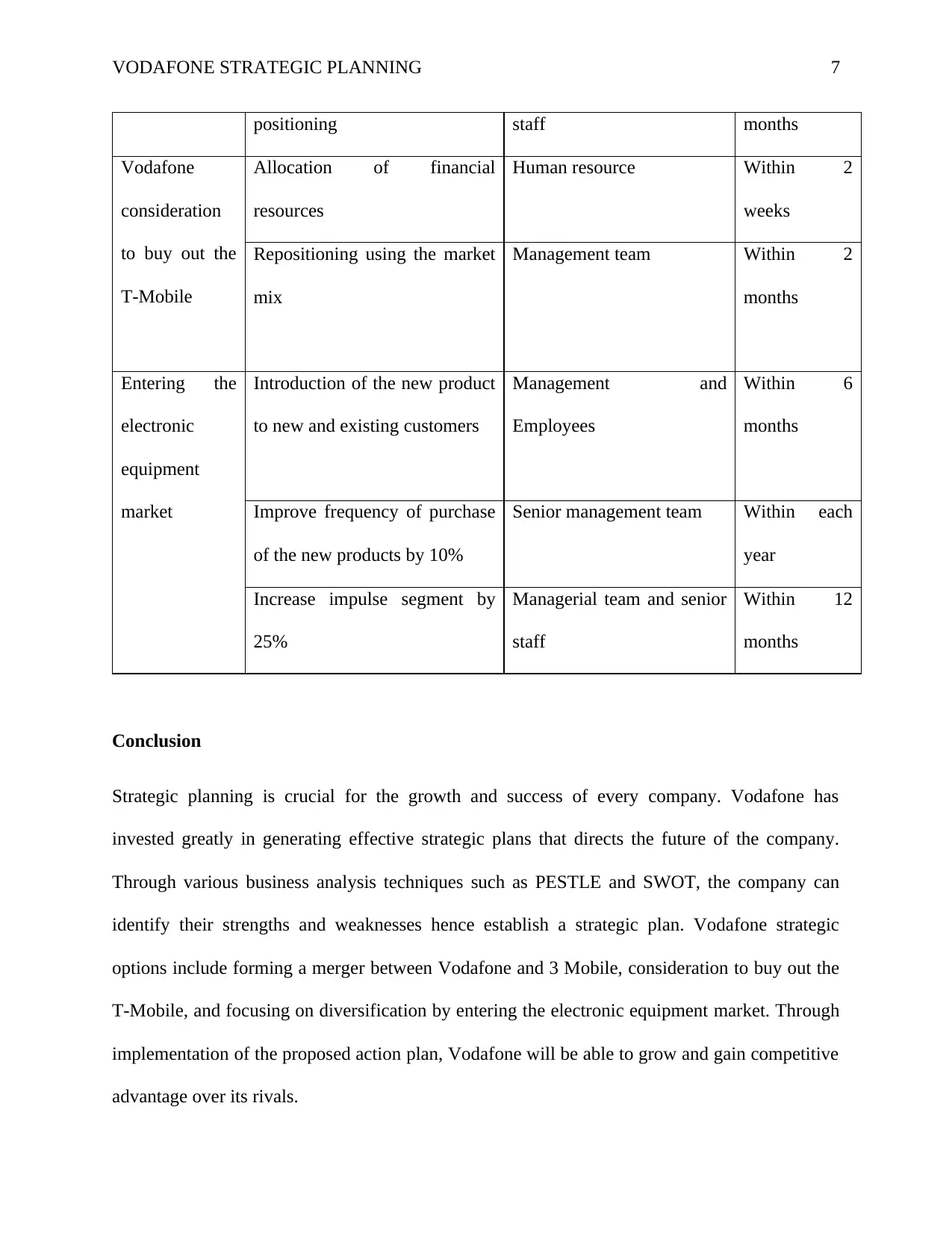
VODAFONE STRATEGIC PLANNING 7
positioning staff months
Vodafone
consideration
to buy out the
T-Mobile
Allocation of financial
resources
Human resource Within 2
weeks
Repositioning using the market
mix
Management team Within 2
months
Entering the
electronic
equipment
market
Introduction of the new product
to new and existing customers
Management and
Employees
Within 6
months
Improve frequency of purchase
of the new products by 10%
Senior management team Within each
year
Increase impulse segment by
25%
Managerial team and senior
staff
Within 12
months
Conclusion
Strategic planning is crucial for the growth and success of every company. Vodafone has
invested greatly in generating effective strategic plans that directs the future of the company.
Through various business analysis techniques such as PESTLE and SWOT, the company can
identify their strengths and weaknesses hence establish a strategic plan. Vodafone strategic
options include forming a merger between Vodafone and 3 Mobile, consideration to buy out the
T-Mobile, and focusing on diversification by entering the electronic equipment market. Through
implementation of the proposed action plan, Vodafone will be able to grow and gain competitive
advantage over its rivals.
positioning staff months
Vodafone
consideration
to buy out the
T-Mobile
Allocation of financial
resources
Human resource Within 2
weeks
Repositioning using the market
mix
Management team Within 2
months
Entering the
electronic
equipment
market
Introduction of the new product
to new and existing customers
Management and
Employees
Within 6
months
Improve frequency of purchase
of the new products by 10%
Senior management team Within each
year
Increase impulse segment by
25%
Managerial team and senior
staff
Within 12
months
Conclusion
Strategic planning is crucial for the growth and success of every company. Vodafone has
invested greatly in generating effective strategic plans that directs the future of the company.
Through various business analysis techniques such as PESTLE and SWOT, the company can
identify their strengths and weaknesses hence establish a strategic plan. Vodafone strategic
options include forming a merger between Vodafone and 3 Mobile, consideration to buy out the
T-Mobile, and focusing on diversification by entering the electronic equipment market. Through
implementation of the proposed action plan, Vodafone will be able to grow and gain competitive
advantage over its rivals.
Paraphrase This Document
Need a fresh take? Get an instant paraphrase of this document with our AI Paraphraser
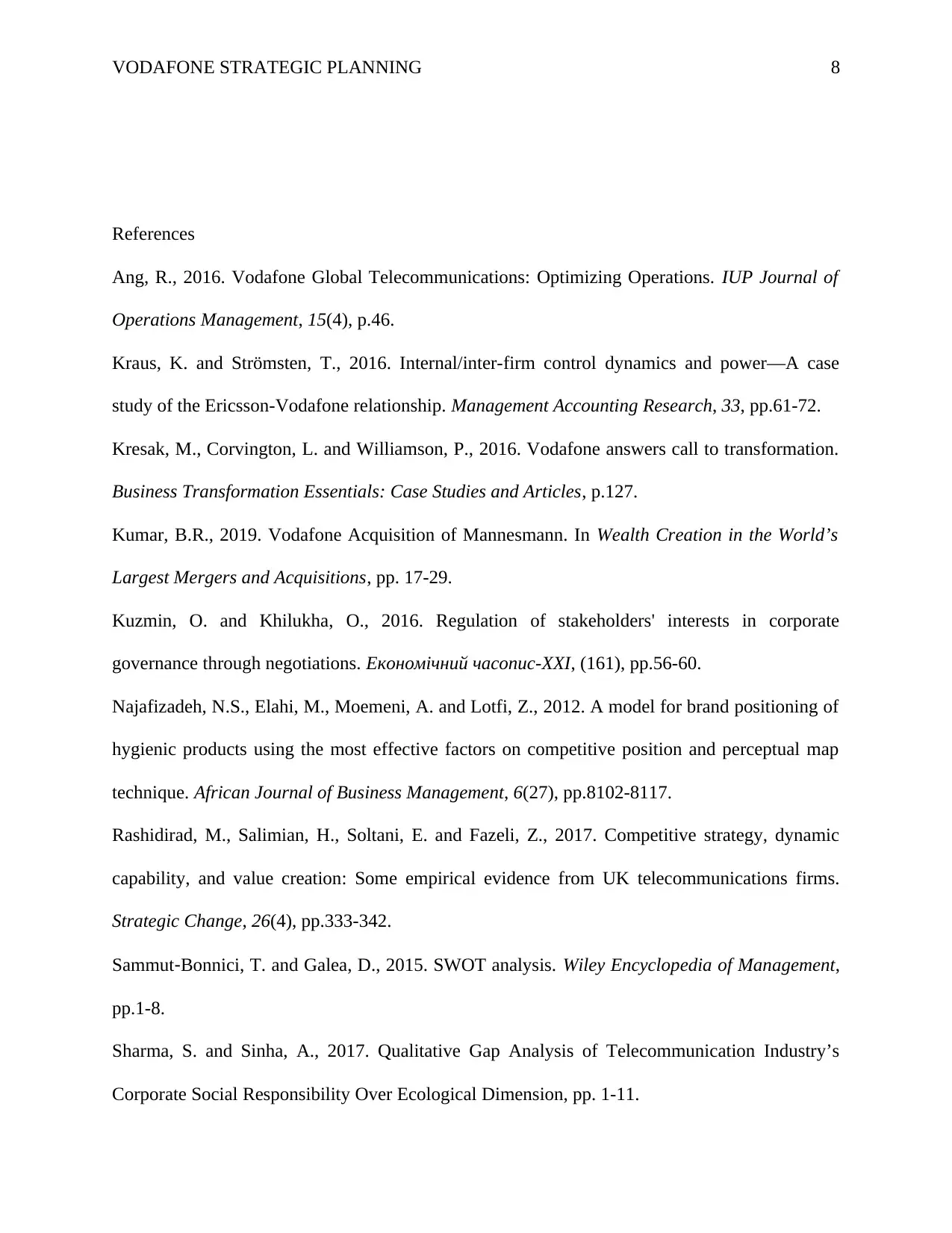
VODAFONE STRATEGIC PLANNING 8
References
Ang, R., 2016. Vodafone Global Telecommunications: Optimizing Operations. IUP Journal of
Operations Management, 15(4), p.46.
Kraus, K. and Strömsten, T., 2016. Internal/inter-firm control dynamics and power—A case
study of the Ericsson-Vodafone relationship. Management Accounting Research, 33, pp.61-72.
Kresak, M., Corvington, L. and Williamson, P., 2016. Vodafone answers call to transformation.
Business Transformation Essentials: Case Studies and Articles, p.127.
Kumar, B.R., 2019. Vodafone Acquisition of Mannesmann. In Wealth Creation in the World’s
Largest Mergers and Acquisitions, pp. 17-29.
Kuzmin, O. and Khilukha, O., 2016. Regulation of stakeholders' interests in corporate
governance through negotiations. Економічний часопис-ХХІ, (161), pp.56-60.
Najafizadeh, N.S., Elahi, M., Moemeni, A. and Lotfi, Z., 2012. A model for brand positioning of
hygienic products using the most effective factors on competitive position and perceptual map
technique. African Journal of Business Management, 6(27), pp.8102-8117.
Rashidirad, M., Salimian, H., Soltani, E. and Fazeli, Z., 2017. Competitive strategy, dynamic
capability, and value creation: Some empirical evidence from UK telecommunications firms.
Strategic Change, 26(4), pp.333-342.
Sammut‐Bonnici, T. and Galea, D., 2015. SWOT analysis. Wiley Encyclopedia of Management,
pp.1-8.
Sharma, S. and Sinha, A., 2017. Qualitative Gap Analysis of Telecommunication Industry’s
Corporate Social Responsibility Over Ecological Dimension, pp. 1-11.
References
Ang, R., 2016. Vodafone Global Telecommunications: Optimizing Operations. IUP Journal of
Operations Management, 15(4), p.46.
Kraus, K. and Strömsten, T., 2016. Internal/inter-firm control dynamics and power—A case
study of the Ericsson-Vodafone relationship. Management Accounting Research, 33, pp.61-72.
Kresak, M., Corvington, L. and Williamson, P., 2016. Vodafone answers call to transformation.
Business Transformation Essentials: Case Studies and Articles, p.127.
Kumar, B.R., 2019. Vodafone Acquisition of Mannesmann. In Wealth Creation in the World’s
Largest Mergers and Acquisitions, pp. 17-29.
Kuzmin, O. and Khilukha, O., 2016. Regulation of stakeholders' interests in corporate
governance through negotiations. Економічний часопис-ХХІ, (161), pp.56-60.
Najafizadeh, N.S., Elahi, M., Moemeni, A. and Lotfi, Z., 2012. A model for brand positioning of
hygienic products using the most effective factors on competitive position and perceptual map
technique. African Journal of Business Management, 6(27), pp.8102-8117.
Rashidirad, M., Salimian, H., Soltani, E. and Fazeli, Z., 2017. Competitive strategy, dynamic
capability, and value creation: Some empirical evidence from UK telecommunications firms.
Strategic Change, 26(4), pp.333-342.
Sammut‐Bonnici, T. and Galea, D., 2015. SWOT analysis. Wiley Encyclopedia of Management,
pp.1-8.
Sharma, S. and Sinha, A., 2017. Qualitative Gap Analysis of Telecommunication Industry’s
Corporate Social Responsibility Over Ecological Dimension, pp. 1-11.
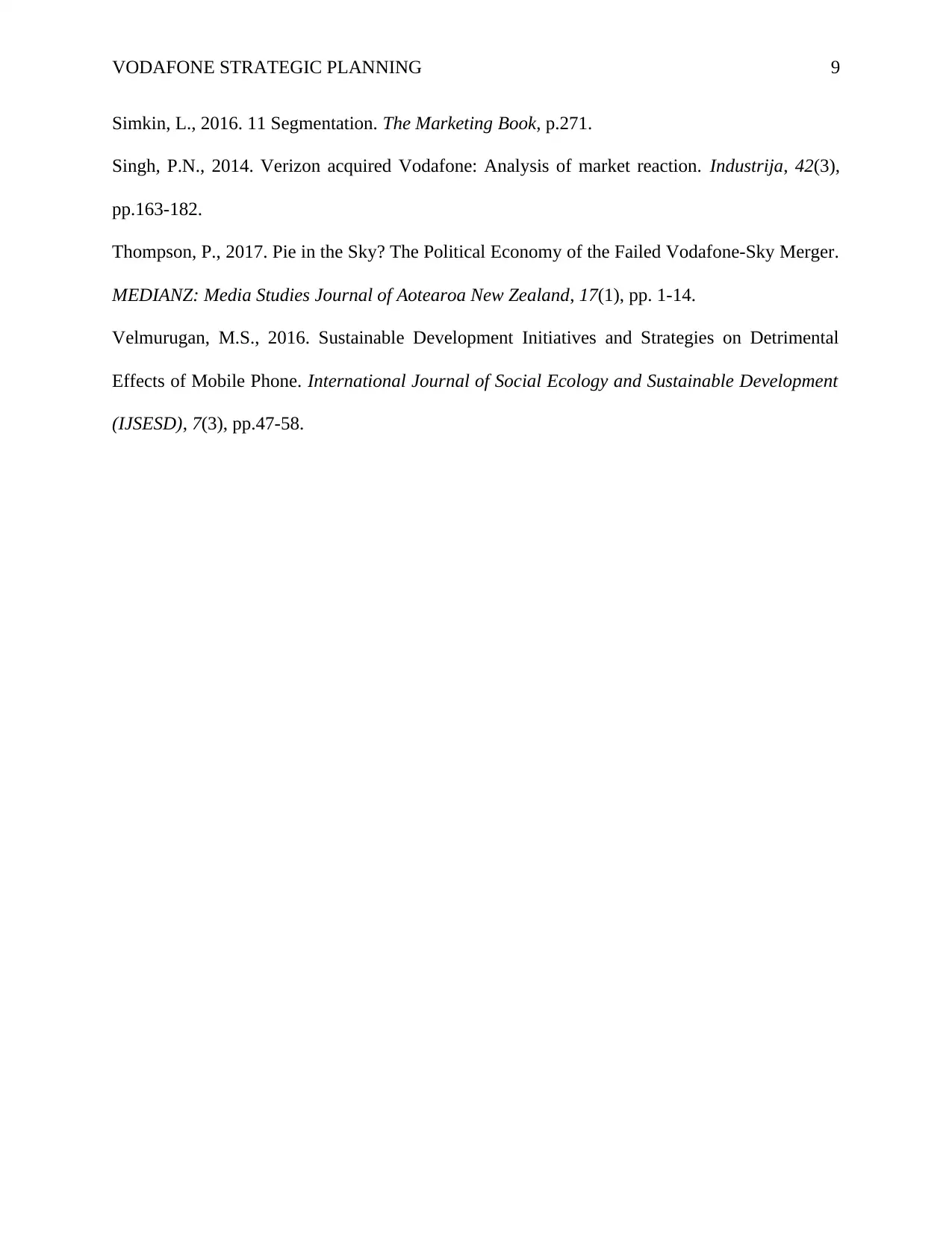
VODAFONE STRATEGIC PLANNING 9
Simkin, L., 2016. 11 Segmentation. The Marketing Book, p.271.
Singh, P.N., 2014. Verizon acquired Vodafone: Analysis of market reaction. Industrija, 42(3),
pp.163-182.
Thompson, P., 2017. Pie in the Sky? The Political Economy of the Failed Vodafone-Sky Merger.
MEDIANZ: Media Studies Journal of Aotearoa New Zealand, 17(1), pp. 1-14.
Velmurugan, M.S., 2016. Sustainable Development Initiatives and Strategies on Detrimental
Effects of Mobile Phone. International Journal of Social Ecology and Sustainable Development
(IJSESD), 7(3), pp.47-58.
Simkin, L., 2016. 11 Segmentation. The Marketing Book, p.271.
Singh, P.N., 2014. Verizon acquired Vodafone: Analysis of market reaction. Industrija, 42(3),
pp.163-182.
Thompson, P., 2017. Pie in the Sky? The Political Economy of the Failed Vodafone-Sky Merger.
MEDIANZ: Media Studies Journal of Aotearoa New Zealand, 17(1), pp. 1-14.
Velmurugan, M.S., 2016. Sustainable Development Initiatives and Strategies on Detrimental
Effects of Mobile Phone. International Journal of Social Ecology and Sustainable Development
(IJSESD), 7(3), pp.47-58.
⊘ This is a preview!⊘
Do you want full access?
Subscribe today to unlock all pages.

Trusted by 1+ million students worldwide
1 out of 9
Related Documents
Your All-in-One AI-Powered Toolkit for Academic Success.
+13062052269
info@desklib.com
Available 24*7 on WhatsApp / Email
![[object Object]](/_next/static/media/star-bottom.7253800d.svg)
Unlock your academic potential
Copyright © 2020–2025 A2Z Services. All Rights Reserved. Developed and managed by ZUCOL.




